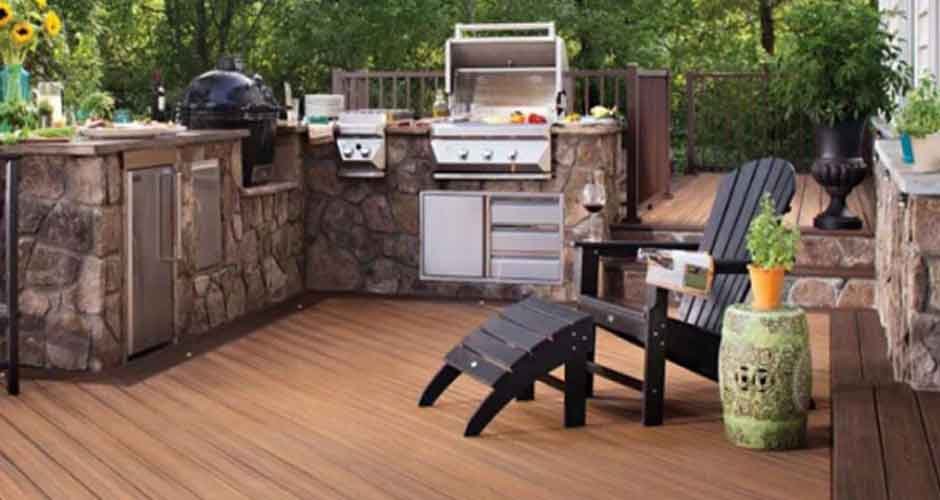One of the most important decisions you must make when designing your ideal deck is the material to be used. Wood and wood-plastic composites are two of the most prevalent alternatives. We will assist you in selecting the ideal decking material, whether you intend to do it yourself or hire a professional, by comparing the advantages and disadvantages of wood and composite decking.
Contractor Tim Slamans explains in an Angi blog post, “The first thing to know about choosing a deck material is that most decks use treated lumber for the framing, which is the structural part of the deck that you don’t usually see unless underneath it.” Consequently, the decision-making process typically pertains solely to the materials that comprise the decking surface and handrails.
Wood Decking Options
A wide variety of wood species are suitable for application as decking and balustrade. In lumberyards across the United States, cedar, redwood, and pressure-treated pine are typical materials. Tigerwood, ipe (pronounced “EE-pay”), and mahogany are tropical hardwood decking options that may appeal to householders interested in exotic wood species.
What Constituents Composite Decking?
Wood-plastic composite decking boards (alternatively referred to as “composite wood decking”) were developed in the late 1980s. They consist of wood fibers encapsulated in plastic. Large-box home improvement retailers, including The Home Depot and Lowe’s, as well as regional lumberyards across the United States, carry composite decking.
Many builders and consumers are turning to high-performance composite decking as they become more aware of the issues associated with wood decking.
Comparing Wood and Composite Decking: Pros and Cons
Wood decking is favored by numerous householders due to its familiarity, accessibility, and affordability. Wooden decking is accompanied by issues such as decay, splinters, and extensive maintenance. While composite wood may require less maintenance than traditional wood, some householders are concerned that it will lack the same aesthetic appeal. However, advancements in manufacturing have produced composites that imitate the natural, opulent appearance of wood without the maintenance difficulties associated with wood decks.
When comparing wood and composite decking, it is important to consider the following:

Which Appears Superior?
Although initial iterations of composite decking had an artificial and plastic-like appearance, certain contemporary composites feature a randomized embossed grain pattern and a variegated appearance to ensure that no two boards are identical.
Which Better Refuses Moisture?
A significant disadvantage of timber decking is that the boards absorb water readily. Wood decking is prone to deterioration by means of warping, splintering, splitting, and decay in the absence of consistent staining, sealing, and painting.
Which Requires the Least Maintenance?
Consistent sealant, staining, and painting are necessary to protect wooden decking from the damaging effects of moisture, temperature, and insects. How often must composite decking be painted, stained, and sealed? Absolutely never! The planks of composite decking require only sweeping or washing to maintain their strength and appearance.
What Is Resistant to Insect Damage?
Wooden decking is susceptible to insect and rodent infestation. Normal sealing and painting can impede the progression of damage, but cannot prevent it entirely. Without the need for painting or sealing, termites and other wood-destroying insects are unable to penetrate composite decking.
What Stains Splinters Away?
Eventually, every type of wood decking will develop splinters, particularly when exposed to temperature and moisture fluctuations. Small wood fibers encapsulated in plastic compose composite decking, rendering it resistant to splintering despite exposure to weather fluctuations. This is particularly crucial in areas where people frequently walk barefoot, such as pool terraces, and for the sensitive feet of children and pets.
What is the difference in cost?
Cost is the primary consideration for householders when deciding between wood and composite decking. Among the advantages and disadvantages of timber decking, affordability is unquestionably a plus. In general, wood decking is more affordable than composites, particularly when considering the initial investment.
Nevertheless, despite the initial lower cost of wood, composite decking typically recoups its investment within two to three years, taking into account the annual maintenance expenses. Additionally, local market conditions and the species of timber selected as opposed to the brand of composite decking impact the price difference.
Which One Is the Most Work-Friendly?
Wood and composites are both simple to trim and fasten with common household instruments. One advantage of composite decking is that it can be bent more easily (via heating) into curved deck sections.
Which Provides A Surface Temperature That Is Lower?
The effects of heat and cold on composite and wood decking are distinct. Wood decking has traditionally exhibited superior performance in summer conditions compared to composites, owing to the fact that the density of composites can cause them to overheat in direct sunlight.
As a result, on sweltering days, your deck will be more comfortable. It is noteworthy that blistering can initiate on the feet at temperatures as low as 109 degrees Fahrenheit. This 35% disparity can be especially significant during the height of summer.
Determining Your Selection
To narrow down the vast selection, it is beneficial to determine which wood decking you prefer most, and then contrast that with your preferred composite decking. Thus, your decision becomes more straightforward, whether it be treated lumber versus composite, cedar versus composite, or redwood versus composite. This eliminates the need to compare dozens of alternatives.






